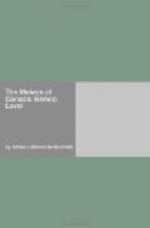Mgr. de Laval strove also to obtain from the Holy Father the canonical union of the abbeys of Maubec and of Lestrees with his bishopric; if he had obtained it, he could have erected his chapter at once, assuring by the revenues of these monasteries a sufficient maintenance for his canons. The opposition of the religious orders on which these abbeys depended defeated his plan, but in compensation he obtained from the generosity of the king a grant of land on which his successor, Saint-Vallier, afterwards erected the church of Notre-Dame des Victoires. The venerable prelate might well ask favours for his diocese when he himself set an example of the greatest generosity. By a deed, dated at Paris, he gave to his seminary all that he possessed: Ile Jesus, the seigniories of Beaupre and Petite Nation, a property at Chateau Richer, finally books, furniture, funds, and all that might belong to him at the moment of his death.
Laval returned to Canada at a time when the relations with the savage tribes were becoming so strained as to threaten an impending rupture. So far had matters gone that Colonel Thomas Dongan, governor of New York, had urged the Iroquois to dig up the hatchet, and he was only too willingly obeyed. Unfortunately, the two governing heads of the colony were replaced just at that moment. Governor de Frontenac and Commissioner Duchesneau were recalled in 1682, and supplanted by de la Barre and de Meulles. The latter were far from equalling their predecessors. M. de Lefebvre de la Barre was a clever sailor but a deplorable administrator; as for the commissioner, M. de Meulles, his incapacity did not lessen his extreme conceit.
On his arrival at Quebec, Laval learned with deep grief that a terrible conflagration had, a few weeks before, consumed almost the whole of the Lower Town. The houses, and even the stores being then built of wood, everything was devoured by the flames. A single dwelling escaped the disaster, that of a rich private person, M. Aubert de la Chesnaie, in whose house mass was said every Sunday and feast-day for the citizens of the Lower Town who could not go to the parish service. To bear witness of his gratitude to Heaven, M. de la Chesnaie came to the aid of a good number of his fellow-citizens, and helped them with his money to rebuild their houses. This fire injured the merchants of Montreal almost as much as those of Quebec, and the Histoire de l’Hotel-Dieu relates that “more riches were lost on that sad night than all Canada now possesses.”
The king had the greatest desire for the future reign of harmony in the colony; accordingly he enjoined upon M. de Meulles to use every effort to agree with the governor-general: “If the latter should fail in his duty to the sovereign, the commissioner should content himself with a remonstrance and allow him to act further without disturbing him, but as soon as possible afterwards should render an account to the king’s council of what might be prejudicial




